The global pet food and supplement market is valued at USD 126.0 billion in 2025 and is slated to reach USD 222.2 billion by 2035, reflecting a CAGR of 5.8%. This growth is driven by increasing pet ownership, rising awareness of pet health and wellness, and the growing demand for premium and specialized pet nutrition products.
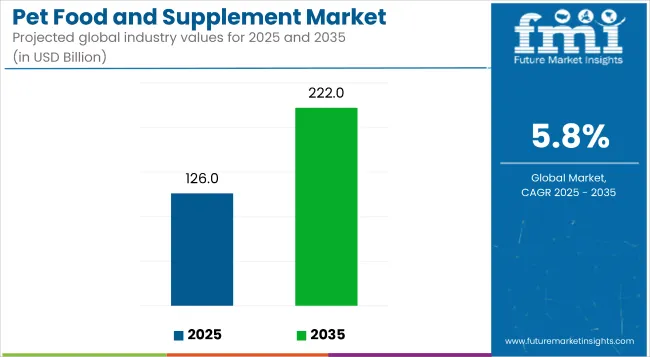
| Metric | Value |
|---|---|
| Market Value (2025) | USD 126.0 billion |
| Forecast Value (2035) | USD 222.2 billion |
| Forecast CAGR | 5.8% |
Innovations in product formulations and expansion of distribution channels are further contributing to the market’s development. Additionally, the rising preference for natural and organic ingredients is fueling demand across key regions globally.
The market is witnessing robust growth, led by Japan at a CAGR of 7.6%, followed by the UK at 7.1%, and the USA at 6.2%. Growth is fueled by government safety regulations, e-commerce expansion, and rising demand for premium, functional nutrition. The offline distribution channel will dominate with a 68.0% market share in 2025, while the dog segment will lead with 47.0%, reflecting growing pet ownership and heightened focus on canine health and wellness.
Government regulations are implemented to ensure the safety, quality, and labeling of pet food and supplements. These regulations help build consumer trust by enforcing strict standards on ingredients and manufacturing processes. In markets like Japan and the United States, regulatory frameworks encourage innovation while safeguarding pet health, thereby supporting the growth and credibility of the pet food and supplement industry.
The market holds a significant share within its parent industries. It accounts for approximately 40% of the overall pet care market, reflecting its central role in pet well-being. Within the animal nutrition market, it represents around 55%, as pet food forms the core of nutritional solutions for companion animals.
In the broader food and beverage market, its share is smaller, at about 3%, due to the vast scope of human consumption products. Within the veterinary healthcare market, pet supplements represent roughly 15%, highlighting their growing relevance in preventive pet health and wellness management.
The market segments include pet type, application, source, distribution channel, food type, and region. The pet type segment covers dogs, cats, freshwater fish, and other pets such as birds, reptiles, and small mammals. The application segment comprises multivitamins, skin & coat, hip & joint, prebiotics & probiotics, calming, and other applications, including immune support, digestive health, and dental care.
The source segment includes organic and conventional sources. The distribution channel segment covers offline and online retail. The food type segment includes wet food, dry food, and snacks/treats. The regional segment includes North America, Latin America, Western Europe, Eastern Europe, South Asia & Pacific, East Asia, and the Middle East & Africa.
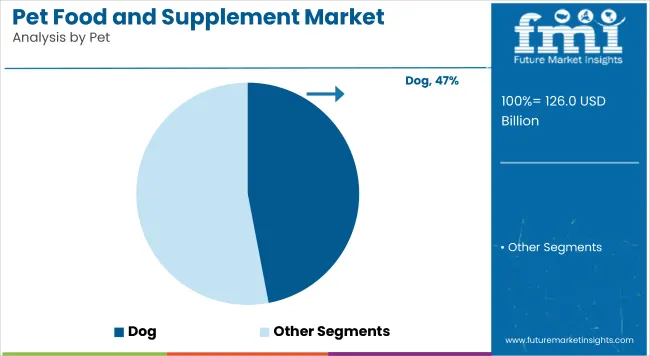
The dog segment is projected to be the most lucrative in the market, capturing a market share of 47% in 2025
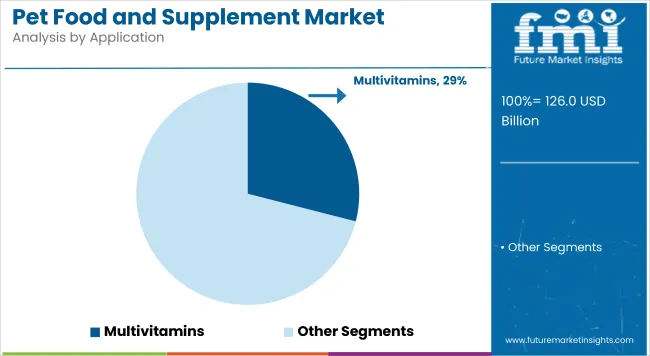
The multivitamins segment is expected to be the most lucrative application segment accounting for 29% of the market share in 2025.
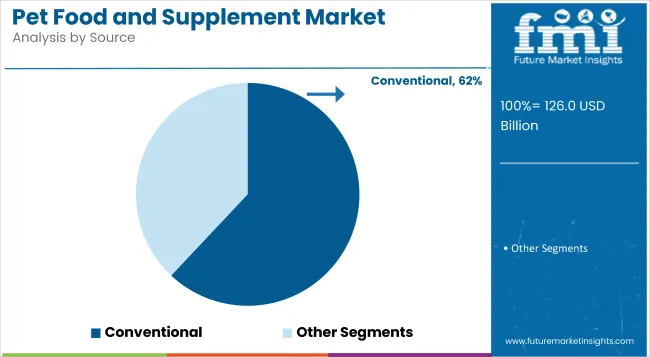
The conventional segment is projected to dominate the market by source, capturing 62% of the market share in 2025.
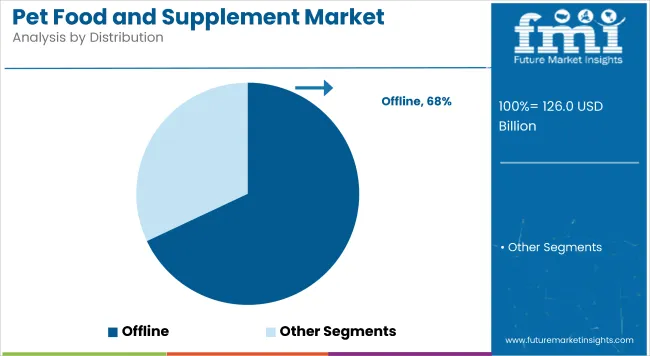
The offline distribution channel is expected to lead the market, accounting for 68% of the market share in 2025.
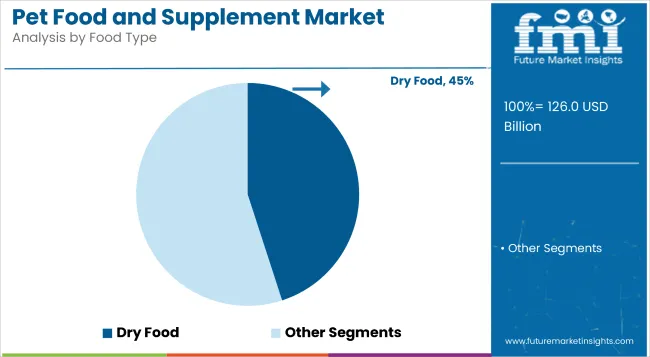
The dry food segment is projected to dominate the market by food type, holding 45% of the market share in 2025
The market is growing steadily, driven by rising pet ownership, increasing awareness of pet health and wellness, and growing demand for premium, functional, and natural nutrition products.
Recent Trends in the Pet Food and Supplement Market
Challenges in the Pet Food and Supplement Market
Among the top five countries in the pet food and supplement market, Japan is expected to exhibit the fastest growth with a CAGR of 7.6% from 2025 to 2035, driven by stringent safety regulations and innovation in specialty products. The UK follows with a 7.1% CAGR, supported by e-commerce expansion and rising demand for premium offerings.
The USA shows steady growth at 6.2% due to personalized nutrition trends. Germany and France are projected to grow at 5.9% and 5.6%, respectively, reflecting increasing demand for natural, multifunctional, and veterinary-approved pet products in mature yet innovation-driven European markets.
The report covers an in-depth analysis of 40+ countries; five top-performing OECD countries are highlighted below.
The USA pet food and supplement market is projected to grow at a CAGR of 6.2% from 2025 to 2035.
The UK pet food and supplements revenue is expected to expand at a CAGR of 7.1% over the forecast period.
Sales of pet food and supplements in Germany are set to grow at a CAGR of 5.9% during 2025 to 2035 in the market.
Sales of pet food and supplements in France are anticipated to grow at a CAGR of 5.6% from 2025 to 2035.
Japan’s pet food and supplements revenue is forecasted to grow at the fastest CAGR of 7.6% through 2035.
The market is moderately consolidated, dominated by tier-one companies such as Mars Petcare, Nestlé Purina Petcare, and Hill's Pet Nutrition, which hold a significant share of the global market. These leaders focus on extensive R&D, global expansion, premium product launches, and leveraging brand trust to maintain their competitive edge.
Top players are intensifying competition through innovative supplement formulations, functional ingredients, and customized nutrition tailored for pet breeds, age, and health conditions. Pricing strategies are adapted for emerging markets, while premium positioning is emphasized in North America and Europe. Partnerships with veterinary networks and investments in e-commerce and DTC (direct-to-consumer) models also shape competitive dynamics.
Recent Pet Food and Supplement Industry News
| Report Attributes | Details |
|---|---|
| Current Total Market Size (2025) | USD 126.0 billion |
| Projected Market Size (2035) | USD 222.2 billion |
| CAGR (2025 to 2035) | 5.8% |
| Base Year for Estimation | 2024 |
| Historical Period | 2020 to 2024 |
| Projections Period | 2025 to 2035 |
| Market Analysis Parameters | Revenue in USD billions /Volume(Kilotons) |
| By Pet | Dog, Cat, Freshwater Fish, Others (Birds, Small Mammals, Reptiles, and Amphibians) |
| By Application | Multivitamins, Skin & Coat, Hip & Joint, Prebiotics & Probiotics, Calming, Others (Immune Support Formulations, Weight Management Supplements, Dental Health Products, and Cognitive Function) |
| By Source | Organic, Conventional |
| By Distribution Channel | Offline, Online |
| By Food Type | Wet Food, Dry Food, Snacks/Treats |
| Regions Covered | North America, Latin America, Western Europe, Eastern Europe, Balkans & Baltic, Russia & Belarus, Central Asia, East Asia, South Asia & Pacific, Middle East & Africa |
| Countries Covered | United States, Canada, United Kingdom, Germany, France, China, Japan, South Korea, Brazil, Australia |
| Key Players | Mars Petcare, Nestlé Purina Petcare, Hill's Pet Nutrition, The J.M. Smucker Company, Blue Buffalo, Diamond Pet Foods, Spectrum Brands, Nutro Products, Wellness Pet Food, Merrick Pet Care, and Ainsworth Pet Nutrition |
| Additional Attributes | Dollar sales by value, market share analysis by region, and country-wise analysis |
The market is valued at USD 126.0 billion in 2025.
It is projected to reach USD 222.2 billion by 2035.
The market is anticipated to grow at a CAGR of 5.8% during the forecast period.
Japan is the fastest-growing market, with a CAGR of 7.6% during 2025 to 2035.
The dog segment leads with a 47% market share in 2025.






Our Research Products

The "Full Research Suite" delivers actionable market intel, deep dives on markets or technologies, so clients act faster, cut risk, and unlock growth.

The Leaderboard benchmarks and ranks top vendors, classifying them as Established Leaders, Leading Challengers, or Disruptors & Challengers.

Locates where complements amplify value and substitutes erode it, forecasting net impact by horizon

We deliver granular, decision-grade intel: market sizing, 5-year forecasts, pricing, adoption, usage, revenue, and operational KPIs—plus competitor tracking, regulation, and value chains—across 60 countries broadly.

Spot the shifts before they hit your P&L. We track inflection points, adoption curves, pricing moves, and ecosystem plays to show where demand is heading, why it is changing, and what to do next across high-growth markets and disruptive tech

Real-time reads of user behavior. We track shifting priorities, perceptions of today’s and next-gen services, and provider experience, then pace how fast tech moves from trial to adoption, blending buyer, consumer, and channel inputs with social signals (#WhySwitch, #UX).

Partner with our analyst team to build a custom report designed around your business priorities. From analysing market trends to assessing competitors or crafting bespoke datasets, we tailor insights to your needs.
Supplier Intelligence
Discovery & Profiling
Capacity & Footprint
Performance & Risk
Compliance & Governance
Commercial Readiness
Who Supplies Whom
Scorecards & Shortlists
Playbooks & Docs
Category Intelligence
Definition & Scope
Demand & Use Cases
Cost Drivers
Market Structure
Supply Chain Map
Trade & Policy
Operating Norms
Deliverables
Buyer Intelligence
Account Basics
Spend & Scope
Procurement Model
Vendor Requirements
Terms & Policies
Entry Strategy
Pain Points & Triggers
Outputs
Pricing Analysis
Benchmarks
Trends
Should-Cost
Indexation
Landed Cost
Commercial Terms
Deliverables
Brand Analysis
Positioning & Value Prop
Share & Presence
Customer Evidence
Go-to-Market
Digital & Reputation
Compliance & Trust
KPIs & Gaps
Outputs
Full Research Suite comprises of:
Market outlook & trends analysis
Interviews & case studies
Strategic recommendations
Vendor profiles & capabilities analysis
5-year forecasts
8 regions and 60+ country-level data splits
Market segment data splits
12 months of continuous data updates
DELIVERED AS:
PDF EXCEL ONLINE
Comprehensive Analysis of Europe Pet Food Supplements Market by Nature, Form, Pet Type and Distribution Channel through 2035
Pet Food Collagen Market Size, Share, Trends, and Forecast 2025 to 2035
Pet Food Pulverizer Market Size and Share Forecast Outlook 2025 to 2035
Pet Food Emulsifier Market Size and Share Forecast Outlook 2025 to 2035
Pet Food Preservative Market Forecast and Outlook 2025 to 2035
Pet Food Ingredients Market Size and Share Forecast Outlook 2025 to 2035
Pet Food Antioxidants Market Size and Share Forecast Outlook 2025 to 2035
PET Food Trays Market Size and Share Forecast Outlook 2025 to 2035
Pet Food Additives Market - Size, Share, and Forecast Outlook 2025 to 2035
Pet Food Processing Market Analysis – Size, Share, and Forecast Outlook 2025 to 2035
Pet Food Market Analysis Size, Share, and Forecast Outlook 2025 to 2035
Pet Food Palatants Market Analysis - Size, Share, & Forecast Outlook 2025 to 2035
Pet Food Packaging Industry Analysis in Europe - Size, Share, and Forecast 2025 to 2035
Pet Food Premix Market Analysis by Pet Type, Ingredient Type, Formand Sales ChannelThrough 2035
Pet Food Microalgae Market Insights - Nutritional Benefits & Growth 2025 to 2035
Pet Food Extrusion Market Analysis by Product Type, Animal Type, Ingredient Type, Extruder Type, Ingredient, Process and Region Through 2035
Pet Food Flavor Enhancers Market – Growth, Demand & Innovation
Food Supplement Ingredients Market Size and Share Forecast Outlook 2025 to 2035
Pet Herbal Supplements Market Size and Share Forecast Outlook 2025 to 2035
Pet Dietary Supplement Market Size and Share Forecast Outlook 2025 to 2035

Thank you!
You will receive an email from our Business Development Manager. Please be sure to check your SPAM/JUNK folder too.
Chat With
MaRIA